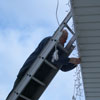
Hanging Lights? Watch Your Step
Now that the turkey is reduced to leftover scraps, many American do-it-yourself-ers are heading to the garage or attic to retrieve the holiday decorations. Depending on the time of the game and how long it takes to untangle the strings of lights, many will soon, if not today, be dragging out the ladder and preparing to ascend. But wait! safety groups say. Each year there are more than 164,000 emergency room-treated injuries in the United States relating to ladders, and you do not want to be one of them.
Taking a minute to scan the following list of ladder safety tips (a list culled from the Web sites of the U.S. Consumer Product Safety Commission, Home Safety Council, and the American Academy of Orthopaedic Surgeons) could help you "rung" in the season safely and ensure a fall-free venture, even if cleaning the gutters first is involved:
- Before using a ladder outdoors, choose a location that is well away from all power lines. Coming in contact with live wires can be fatal.
- Place the ladder on level ground and open it completely, making sure all locks are engaged.
- Use the 4-to-1 rule for extension ladders: for each 4 feet of distance between the ground and the upper point of contact (such as the wall or roof), move the base of the ladder out 1 foot.
- Always face the ladder when climbing and wear slip-resistant shoes, such as those with rubber soles.
- Keep your body centered on the ladder and gauge your safety by your belt buckle. If your buckle passes beyond the ladder rail, you are overreaching and at risk for falling.
- Inspect the ladder. Check it for any loose screws, hinges, or rungs that might not have been fixed from its last use. Clean off any oil, dirt, or other substance that could be slippery.
- Make sure rungs are dry before using the ladder.
- Stand at or below the highest safe standing level on a ladder. For a stepladder, the safe standing level is the second rung from the top, and for an extension ladder, it's the fourth rung from the top.
- Make sure the weight your ladder is supporting does not exceed its maximum load rating (user plus materials). There should only be one person on the ladder at one time.
- Use a ladder that is the proper length for the job. Proper length is a minimum of 3 feet extending over the roofline or working surface. The three top rungs of a straight, single or extension ladder should not be stood on.
- Straight, single or extension ladders should be set up at about a 75-degree angle.
- All metal ladders should have slip-resistant feet.
- Do not place a ladder in front of a door that is not locked, blocked, or guarded.
- Be careful when climbing. Ask someone to hold the ladder to provide stability while you climb up and down. Stay in the center of the ladder as you climb, and always hold the side rails with both hands.
- Move materials with caution. If you need to move large items or equipment while on the ladder, do so slowly and carefully. Moving heavy items suddenly can cause you to be thrown off-balance and fall.
- Do not use a ladder as a seat between tasks. You might want to take a break from your chores, but never use the top step or pail shelf as a seat--not even on a stepladder.
- Never leave a raised ladder unattended.
- Follow use instruction labels on ladders.